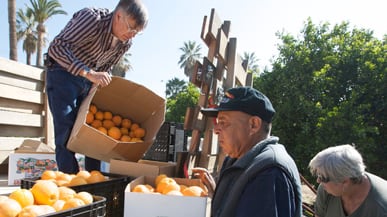In the battle against food waste and hunger, the ancient tradition of gleaning is gaining new admirers around America. Kathleen Maloney on how it's changed the D.C. food system.
With the rise of obesity levels and food prices in the U.S., very little attention has been paid to the efforts of the hundreds of thousands of volunteers who salvage millions of pounds of fresh food every year by gleaning—the collection of food left behind from a harvest—which provides those in need with free or inexpensive healthy produce they otherwise would have no access to.

Parker Farms in Oak Grove, Virginia, has been welcoming gleaning groups since the late 1980s, to gather what is left behind from the harvests. "The biggest value to the farm is that product that was raised for the purpose of consumption, is consumed," said Rod Parker, general manager, who added that much of the food gleaners gather was initially left behind for purely cosmetic reasons—a curved cucumber or a sparse ear of corn. "A curved cucumber, when you slice it, nobody knows it was ever curved."
During warmer months, groups from Bread for the City's program called Glean for the City travel to Parker Farms with their volunteers to gather that discarded or overlooked produce, sometimes collecting up to 2,000 pounds in a single trip. Sharon Gruber, a nutrition consultant with Bread for the City, began Glean for the City when she was hired and realized that their clients needed not only food, but healthy food. "I quickly realized we couldn't buy all the produce I wanted us to buy."
So she began cold-calling farms—150—to ask them what they did with their unwanted or unmarketable produce. That is how she found out about gleaning. Bread for the City now organizes trips to participating farms where produce like apples, sweet corn, squash, and broccoli are collected directly from the fields. This year they will also make an effort to involve people in the gleaning.
The organization receives about half its produce directly from the farm, Gruber said, and half from farmers' markets in the area that participate in gleaning by donating food left over at the close of the markets. Many of the Washington, D.C.-area farmers' markets that participate in gleaning are the FreshFarm Markets, one of which is just a block from the White House and was visited on its opening day last year by Michelle Obama, champion of the national Let's Move! campaign. The government's community service website, serve.gov, also features a USDA "Let's Glean!" tool kit, with information and facts about the process.
“There is a lack of comprehension of where food comes from,” he said, adding that it is not uncommon to hear questions from students like “How did you get these eggplants on these bushes?”
FreshFarm Markets co-founder Bernadine Prince said 10 of the organization's 11 farmers' markets donated almost 60,000 pounds of fresh food and goods last year. Everything from vegetables to bread to flowers is donated, as well as unclaimed CSA, or Community Supported Agriculture, boxes—shares of crops community members purchase through annual subscriptions.
The D.C. Central Kitchen has been gleaning thousands of pounds of food from farmers' markets, like the Dupont Circle FreshFarm Market, for about 12 years. Two years ago, they began gleaning directly from farms to introduce more fresh produce into the diets of the people they serve. CEO Michael Curtin said volunteers often include students from the schools for which the organization provide meals, some of whom are used to food that comes only from boxes and cans. "There is a lack of comprehension of where food comes from," he said, adding that it is not uncommon to hear questions from students like "How did you get these eggplants on these bushes?"
The food distribution system employed by the D.C. Central Kitchen creates a full circle of service. Often their volunteers glean food directly from fields and farmers' markets, and then brought for preparation to their kitchens, which are largely staffed with members of their Culinary Job Training program that educates groups like recovering addicts and previously incarcerated people for work in the food services industry. The prepared food is then distributed into the community through shelters, halfway houses and the like, where many of the culinary trainees may have once been.
Donating food used to be much more complicated because of different states' liability laws, but in 1996, President Clinton signed the Bill Emerson Good Samaritan Act, which freed producers from liability should the donated food cause any harm, as long as it was donated "in good faith."
There are mentions of gleaning that can be traced back to the Old Testament, in which farmers are told to allow the gleaning of their land—the gathering of left over or unwanted produce either by or for the needy. They are told to leave the food left behind from their harvests for widows, orphans, travelers, and the like. In France, gleaning is still often practiced in this traditional way, as shown in a 2000 Agnes Varda film called Les Glaneurs et la Glaneuse or, The Gleaners and I. The film depicts gleaners from many walks of life in France. In the United States, faith-based and non-denominational groups have dedicated themselves to salvaging some of the 100 billion pounds food this country wastes every year.
One of the largest national faith-based gleaning organizations began long before the federal protections were extended. Executive director of the Society of St. Andrew, Steven M. Waldmann, said their national gleaning network was the first of its kind when it began in the mid-'80s. They began by salvaging food from trucks turned away from markets because the produce was too big, too small or too something else, but perfectly edible. They now organize field gleaning trips for anyone willing to participate, regardless of religious affiliation. "We are a faith-based org, however, we don't engage in active proselytizing. We believe if you are hungry you should be fed."
The hungry that the Society of St. Andrew has fed are many. Since the group's beginning, about 400,000 volunteers have harvested almost 164 million pounds of food nationwide, averaging about 30,000 volunteers a year, who harvest an average of 15 million pounds of food. With more organizations like these, an increasingly large dent could be put into that 100 billion pounds of food Americans waste each year, while also feeding those in need.
"People pay money to go apple picking," Sharon Gruber pointed out. These trips are free, and you won't have to figure out what to do with two bushels of apples.






